There are times when the vintage aviation community can seem like a whole other world. Growing up in rural South Carolina, the idea that I might one day work on historic aircraft always seemed remote. Flying is an expensive hobby and that expense can easily intimidate people. The attitudes and demeanor of some can certainly go far in scaring people away. But in my mind, the folks at the Berlin Airlift Historical Foundation have always stood out as being uniquely courteous and inviting. I can recall attending shows and seeking them out as a teenager precisely because I knew they welcomed my interest and constant questions.
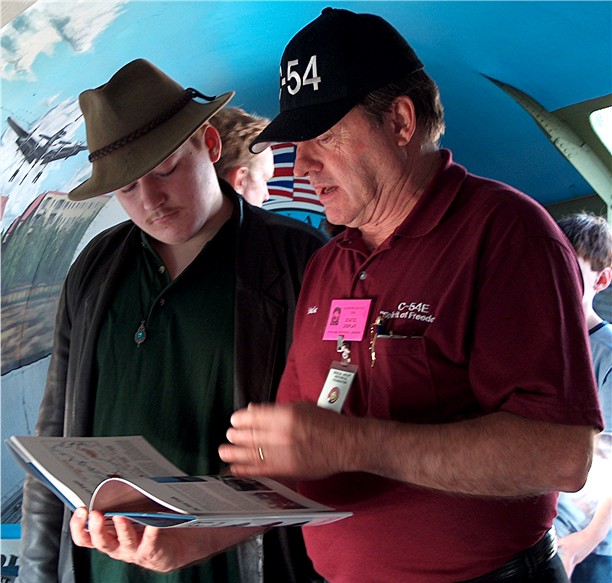
Here I am visiting the BAHF’s crew at 19 years old, nearly 20 years ago.
We should all be so forthcoming.
I often joke that I like my aircraft big and lumpy, the old piston engine bombers and transports of the gold and silver age of aviation hold a never-ending fascination for me. The BAHF have long maintained an airworthy Douglas C-54 Skymaster – 44-9144, which saw service with the US Navy as BuNo 90414 – in honor of those transports who dutifully carried out history’s most ambitious mission of mercy. And as much as I love the Skymaster, I kept waiting for the day that they would bring their Boeing C-97 to my neck of the woods too.
But time catches up with us and the BAHF have endured some trying events. The C-97 is a monster to maintain, her period reputation as a hangar queen still holding true to this day. This burden became catastrophic when tornadoes damaged their C-54 beyond repair in 2020. The organization was able to rebound by locating another C-54 – an actual Berlin Airlift veteran, 43-17228 – but the strain was felt in their efforts to keep the C-97 running.
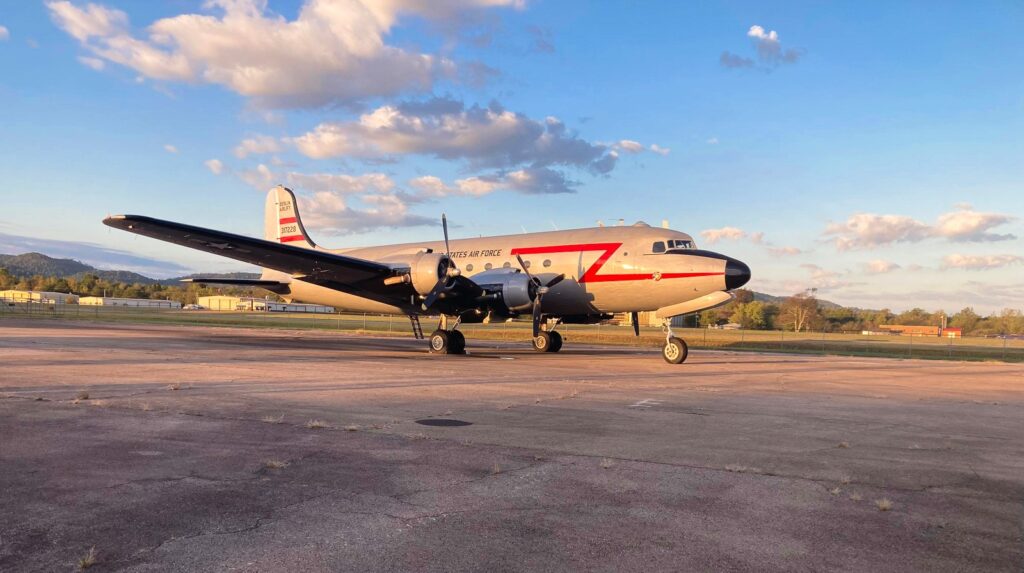
Douglas C-54 Spirit of Freedom II (43-17228) of the Berlin Airlift Historical Foundation. Photo by Kevin Kearney.
When the opportunity came for me to come up and see the C-97 in person, I jumped at the opportunity. And true to form, it was an honor to hang out with the BAHF team. Special thanks to Kevin Kearney and the Berlin Airlift Historical Foundation for allowing me to check out Angel of Deliverance.
The Berlin Airlift
Before beginning, it may be prudent to talk about the event which this organization seeks to remember:
As a historian, the dismissive attitude of many toward the evils of communism and the ignorance of the Cold War is haunting. The ultimate form of socialism, communism regimes were responsible for the deaths of nearly 100 million people throughout the 20th Century. While this ideology had first taken route in Russia during the Great War, it was not until the Second World War that people began to understand its nature on a global scale. The war in Europe began with Germany and the Soviet Union signing a non-aggression pact, then mutually invading eastern Europe, dividing nations like Poland in two. When the National Socialist government of Germany was unable to secure a peace with Britain following the fall of France, and furthermore failing to bring Britain to bear by force, Germany, starved of resources, broke its pact and invaded the Soviet Union in 1941. Under the logic of ‘the enemy of my enemy is my friend,’ this event immediately led the Allied powers to make a Faustian bargain by bringing the Soviet Union into the fold.
For the next four years, the atrocities of the Soviet Union were quietly ignored while the Soviet Union fought bloody campaign after campaign westward. While British Prime Minister Winston Churchill openly deplored this alliance of necessity, the US administration under Pres. Franklin D. Roosevelt was more forgiving, with recently declassified Venona papers revealing extensive Soviet infiltration of his government. When it became clear that the Soviet Union had no intention of leaving the nations it liberated, instead setting up puppet governments, the seeds of the Cold War were planted. Churchill referred to this divide as an “iron curtain” in a 1946 speech:
From Stettin in the Baltic to Trieste in the Adriatic, an iron curtain has descended across the Continent. Behind that line lie all the capitals of the ancient states of Central and Eastern Europe. Warsaw, Berlin, Prague, Vienna, Budapest, Belgrade, Bucharest and Sofia; all these famous cities and the populations around them lie in what I must call the Soviet sphere, and all are subject, in one form or another, not only to Soviet influence but to a very high, and in some cases increasing, measure of control from Moscow.
Being the point where two superpowers met, Germany would remain the epicenter of this conflict for the next 45 years.
The Allied powers divided Germany into occupation zones after the war between Britain, France, the United States, and the Soviet Union. Berlin, which lay in the Soviet zone, was itself divided in the same manner. Tensions rose as the people of Berlin voted heavily against communist-backed officials. This was typical of the decades long struggle ahead – capitalism could survive in a world with communism, but communism could not survive in a world with capitalism. The final straw saw the Soviets refuse to accept Germany reintroducing its own currency, the Deutsche Mark, in place of that circulated by the Soviets. The next day, 19 June 1948, the Soviet Union closed all road and rail access into Berlin.
These pathways into Berlin had been taken for granted by the Allied powers, so they fell back to the one access point which had been formally agreed to prior: airways. This was the beginning of Operation VITTLES – the Berlin Airlift.
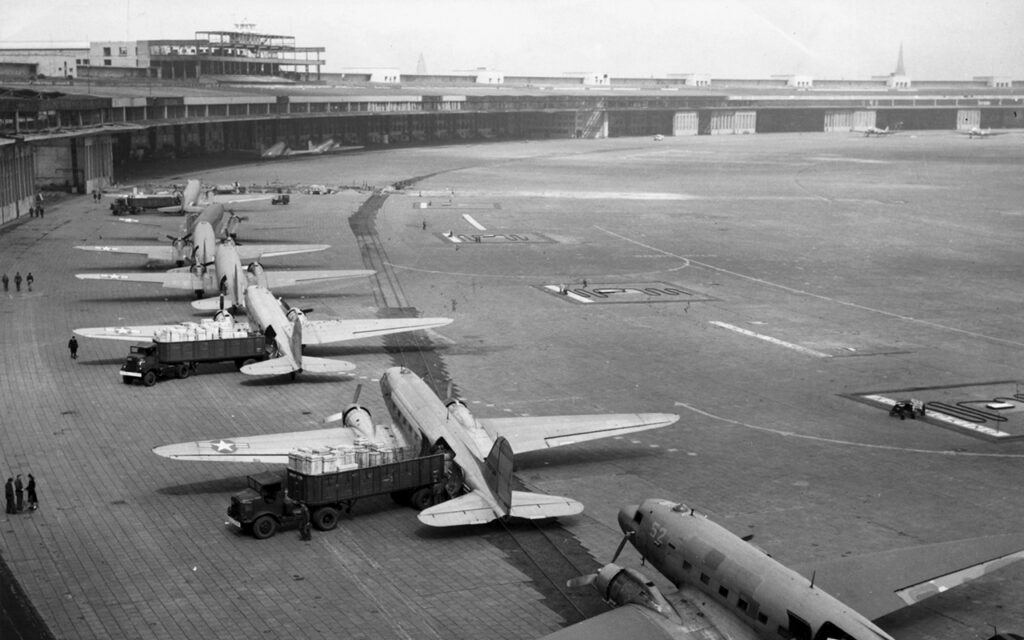
Just three years after bringing Germany to the brink of ruin, the same airmen who once rained death and destruction upon the German people were now vital in keeping the people of Berlin alive. The city’s population of 2 million held a reserve of roughly 35 days worth of food and 45 days worth of fuel. To provide for them, the Allied powers needed fly in an average of 5,000 tons of cargo a day. This daily intake included such figures as 646 tons of flour, 109 tons of meat, 180 tons of sugar, and 144 tons of vegetables, all calculated to sustain the German people on a 2,000 calorie a day diet. However, the most urgently needed commodity was coal, with the daily requirement being some 3,475 tons.
When the US Air Force began said effort, its transport allotment in Europe amounted to 70 Douglas C-47s, capable of carrying three tons each.
CG US Air Forces in Europe Lt Gen Curtis E. LeMay did what he could but it was not until the arrival of Maj Gen William H. Tunner that things really began moving. Tunner was already an airpower legend by this point, having organized the Women’s Air Service Pilots program and the routine cargo flights over the Himalayas (known as “the Hump”) into free-China while Allied forces to fought to retake the Burma land route. Arriving on 28 July, Tunner studied the failed Luftwaffe airlift campaign to support the encircled Sixth Army of Stalingrad in 1942. The problem, Tunner concluded, was not one of aircraft or resources, but one of organization.
Throughout August, Tunner began implementing drastic changes. No longer were aircraft to stack themselves at various altitudes in orbit, rather, they were to stack themselves out in a linear pattern so that a stack of five, for example, would have a line of aircraft 15 minutes apart from one another. By doing this, each transport would come in for approach every three minutes. If they should miss the landing, rather than circle around the airport, they were to return to base rather than break their position.
Large numbers of Douglas C-54s, the C-47’s replacement, were hastily brought in, with over 40% of the types entire complement (some 225 aircraft) participating in the airlift. Not only did the C-54 have a larger payload (some 14 tons), but its tricycle landing gear allowed for easier unloading. The aircrews were to stay with their aircraft at all times, with food and provisions being driven out to the waiting transports. The unloading of the cargo wash handled by the locals themselves.
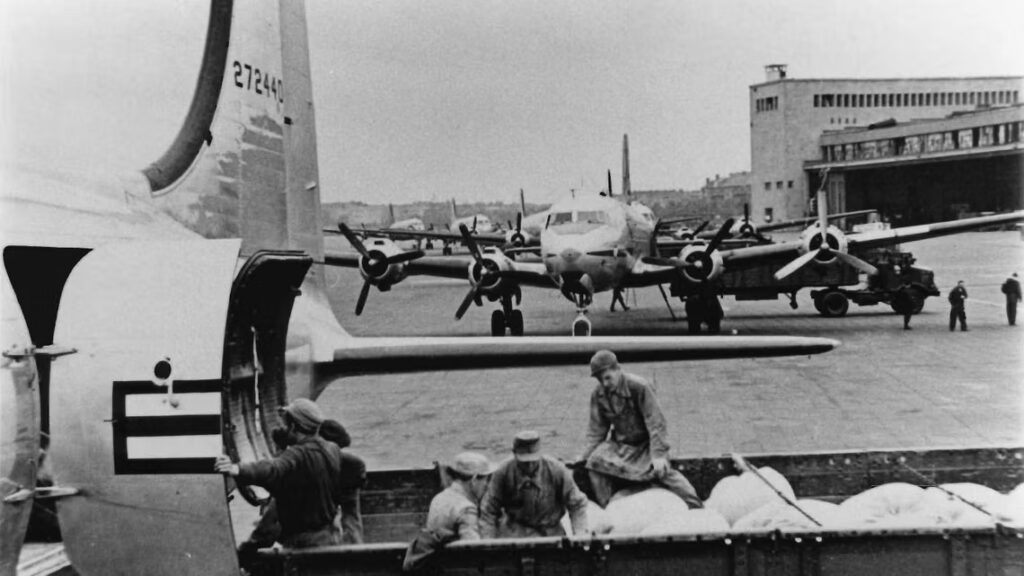
Incredibly, the US reached the 5,000 tons a day mark by the end of August. And it just kept going. On 15 April 1949, Easter Sunday, Tunner’s aircrews set a record delivering 12,941 tons of coals, carried by 1,383 flights, in a period of 24 hours. The Soviet blockade, intended to humiliate the Western Allies, was now doing the exact opposite. One transport pilot, haunted by the sight of starving children, began dropping candy tied to small handkerchief parachutes from his plane to the crowds watching the airplanes land and takeoff. When word got out about 1st Lt Gail S. Halvorson’s actions, Tunner created Operation LITTLE VITTLES on 22 September 1948, encouraging other transport crews to do the same.
With crowds of children eagerly following the coming and goings of Allied transports, the people of Berlin not only refusing Soviet rations but helping the Western Allies to unload theirs, and the airlift capacity steadily growing, it should come to no surprise that the same day that the airlift hit its daily tonnage record, the Soviets finally indicated a willingness to negotiate an opening to the blockade. The blockade was lifted on 12 May 1949, though the airlift continued to build up supplies until 30 September.
In the end, the Western Allies imported some 1.7 million tons of cargo into Berlin, flying some 278,000 flights, totaling over 92 million miles. At its peak, one transport landed in Berlin every 30 seconds.
Still, Berlin remained a sore spot for the Soviet Union. The following decade saw Berlin become the focal point for immigration of peoples fleeing communist rule. A wall, separating East and West Berlin, was erected in 1961 to stem this flow. This Berlin Wall would remain in place until its fall in 1989, the first of a series of events which culminated in the collapse of the Soviet Union. Throughout this period, more than 600 people were killed trying to cross the border from East Germany into West Germany, with at least 140 of them being killed at the Berlin Wall.
Such is the legacy of communism. Kudos to the Berlin Airlift Historical Foundation for their efforts to preserve the memory and lessons of the Cold War.
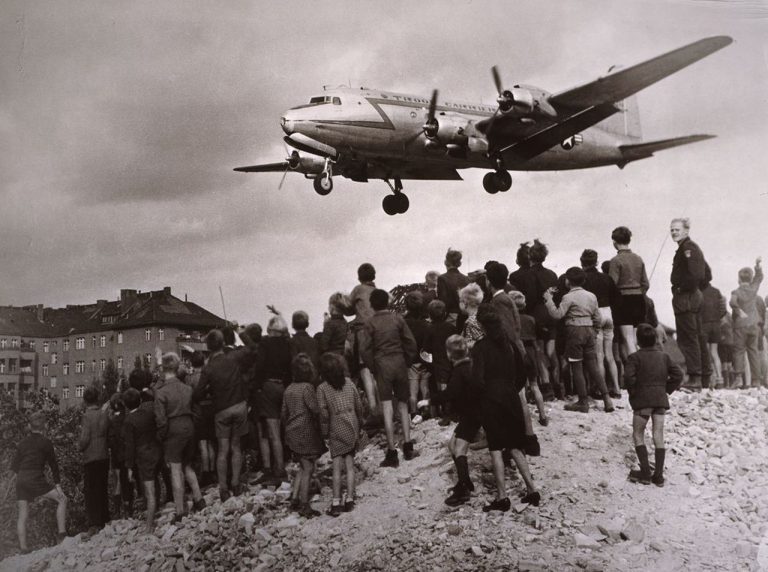
Boeing C-97 Angel of Deliverance
In the waning years of the Second World War, US aircraft companies began to look toward the future of commercial aviation, designing airliners based on wartime technologies. This lead to a postwar triad between the Douglas DC-6, Lockheed Constellation, and the Boeing Stratocruiser. Variants of these three would serve as the last prop driven airliners in the United States.
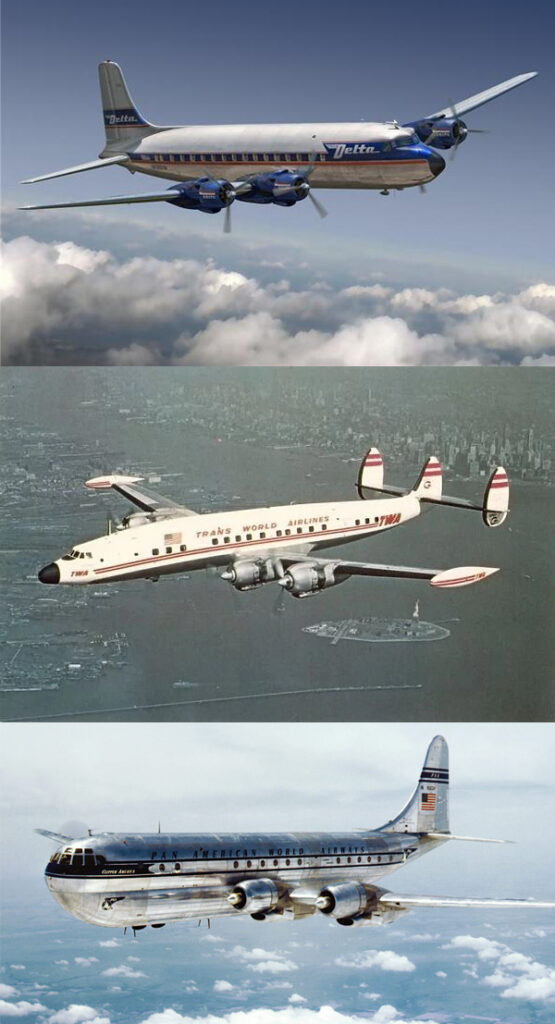
The largest of the three, the Stratocruiser was based on the B-50 Superfortress II, itself a development of the B-29 Superfortress, famed for its role in defeating Japan. Fully pressurized with an upper passenger deck and lower cargo hold, the Stratocruiser weighed nearly 84,000 pounds empty. By comparison, the competing Douglas DC-6 weighed 43,000 pounds.
With its high passenger complement and long range, it at first seemed a given that the Boeing design would dominate the postwar airline boom. It did not. The issue was the engines. The infamous Wright R-3350s which had dogged the B-29 were replaced in the B-50, upgrading to Pratt & Whitney R-4360s. The Stratocruiser used these same engines. The R-4360 was indeed more reliable than the R-3350, but was also considerably larger. For example, the R-3350 engine had eighteen cylinders; the R-4360 had 28. It was also quite finicky and maintenance costs were such that the Stratocruiser rarely made a profit outside of international flights.
Boeing’s giant airliner was more successful in the military, being particularly renown for its conversion into the KC-97 Stratotanker. Stratotankers were highly regarded and had a long run serving with the US Air Force from 1951 until 1978. Today all surviving Stratocruisers are former tankers, and while some have been converted back into transports, none have been converted to the airliner configuration. Today, the BAHF’s Angel of Deliverance is the sole surviving Stratocruiser (technically, a Stratofreighter) to still be airworthy.
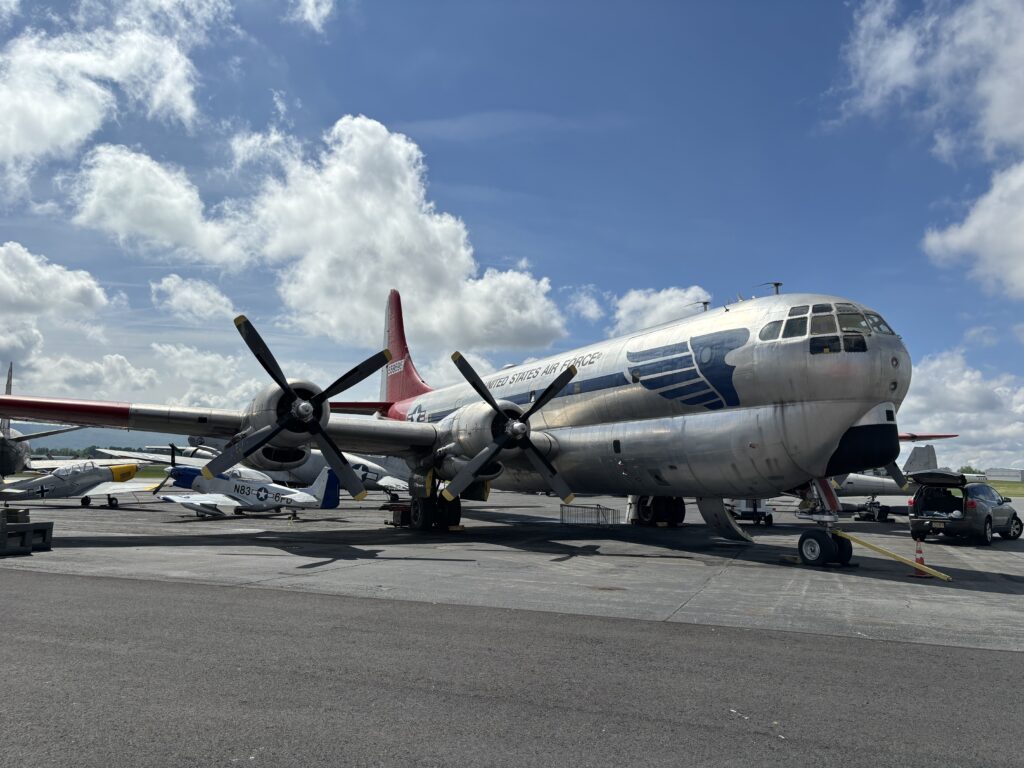
Angel of Deliverance sitting on the ramp outside the Mid Atlantic Air Museum in Reading, Pennsylvania.
Photo taken 11 May 2024.

Angel of Deliverance in her military service. Originally delivered as a KC-97G Stratotanker 52-2718, she served from 1954 to 1976.
Many of these years were spent in Air National Guard units and this photo, taken during Operation CREEK PARTY, is an example of this. With the Vietnam War overtaxing the US Air Force in also being able to respond to Soviet aggression in Western Europe, CREEK PARTY sought to supplement active duty tankers by calling Air National Guard units overseas. The McDonnell Douglas F-4 Phantom being refueled here, 68-0556, carries a tail code showing that she was based at Zweibrücken in Germany. At the time this photo was taken, 52-2718 was also based in Germany, at Rhein-Main.
The Berlin Airlift Historical Foundation acquired 52-2718 in 1996.

Angel of Deliverance is painted in the colors of 45-59595, one of nine Boeing C-97s accepted by the US military for service trials. 45-59595 was a YC-97A, sharing the revised tail, wing, and engines also found on the Boeing B-50 Stratofortress II. The Berlin Airlift was a natural test case for the heavy lifting capabilities of the transport, and 45-59595 arrived at Rhein-Main on 2 May 1949. The sole Stratocruiser to participate in the Berlin Airlift, 45-59595 flew some 23 sorties that month, delivering some 445 tons of cargo before engine problems forced her recall to the United States.
The photo above shows her participating in the airlift.
Experience with 45-59595 and the competing Douglas C-74 Globemaster, (who was also undergoing trials at the airlift), revealed the necessity for purpose-built heavy lifting aircraft for the US Air Force.

In 1988, 52-2718 was acquired by Grace Aire Medical Foundation of Corpus Christi, Texas. A humanitarian organization, she regularly flew flights to South America. I was told that, in this mission, she served as a mobile surgical center, specializing in the repair of cleft lip and palate operations.
This photo was taken by Michael Roeser in Greybull, Wyoming around 1991. It shows 52-2718 under the name Spirit of Corpus Christi.
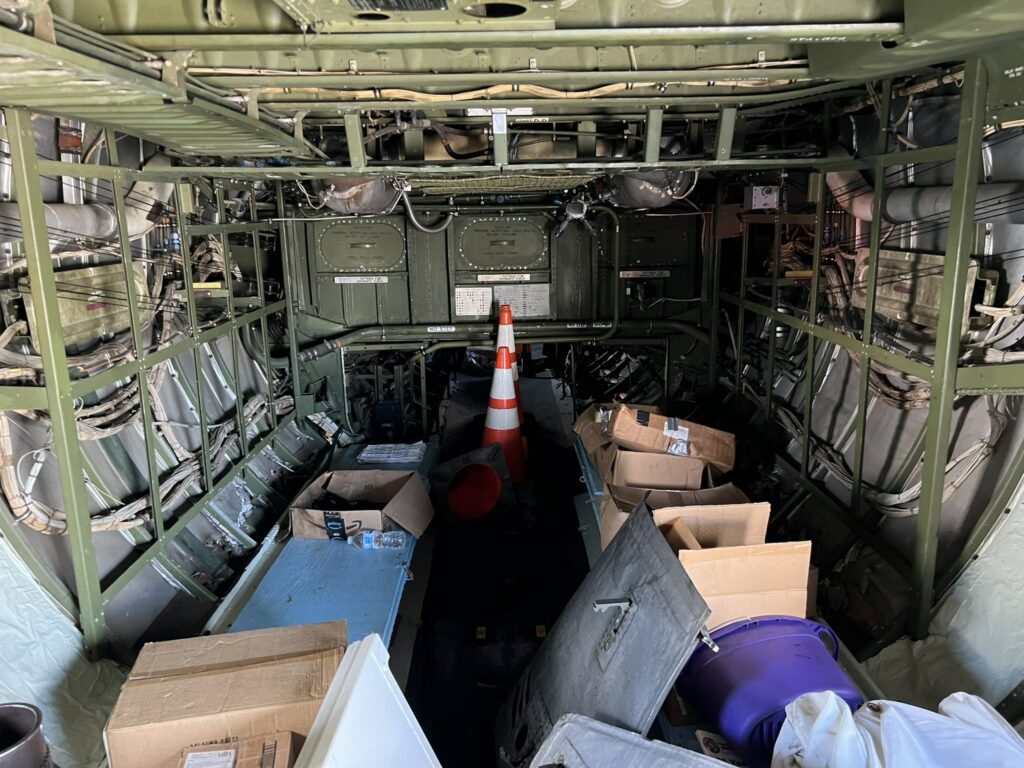
Crawling up the entry ladder into the forward compartment, this is the view looking back toward the aircraft’s main wing spar.
Photo taken 11 May 2024.

Originally the Stratocruiser was promoted as the Boeing 377 airliner, with 31 flying with Pan American Airways. Unfortunately, the 377 proved too costly to compete with the Douglas DC-4 and Lockheed Constellation. The aircraft’s large size and temperamental Pratt & Whitney R-4360 engines made it difficult for the aircraft to turn a profit anywhere except on longer routes. As such, they were some of the first to be retired after the introduction of jet airliners like the Boeing 707.
One of the more fascinating aspects of the 377 was its lounge area, comprising the lower compartment previously shown on Angel of Deliverance. Here the camera is facing forward, while the previous photo was facing aft. The crude military ladder was replaced by a spiral staircase in civilian use. This arrangement would latter be copied with the upper deck of the famous Boeing 747.
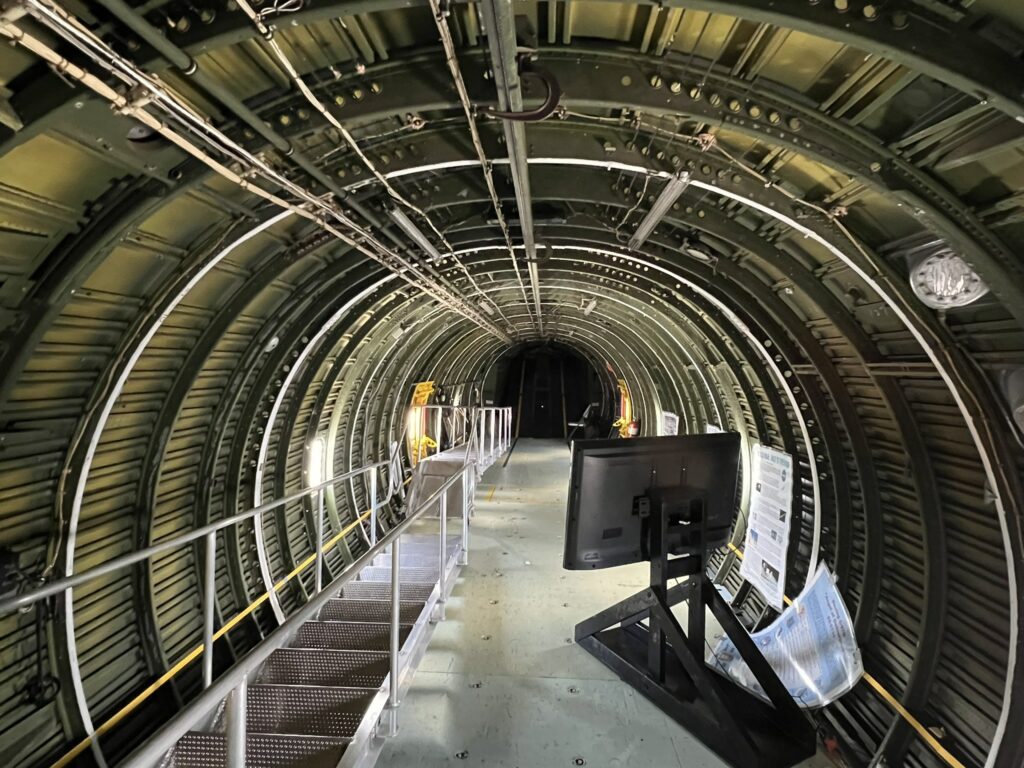
Standing at the top of ladder from the lower deck, looking back into the C-97’s main cargo deck. The viewer is looking toward the tail where the C-97’s loading ramp is stowed. Along the ceiling is runs a rail assembly with an electric hoist to aid in hauling cargo aboard.
Photo taken 11 May 2024.
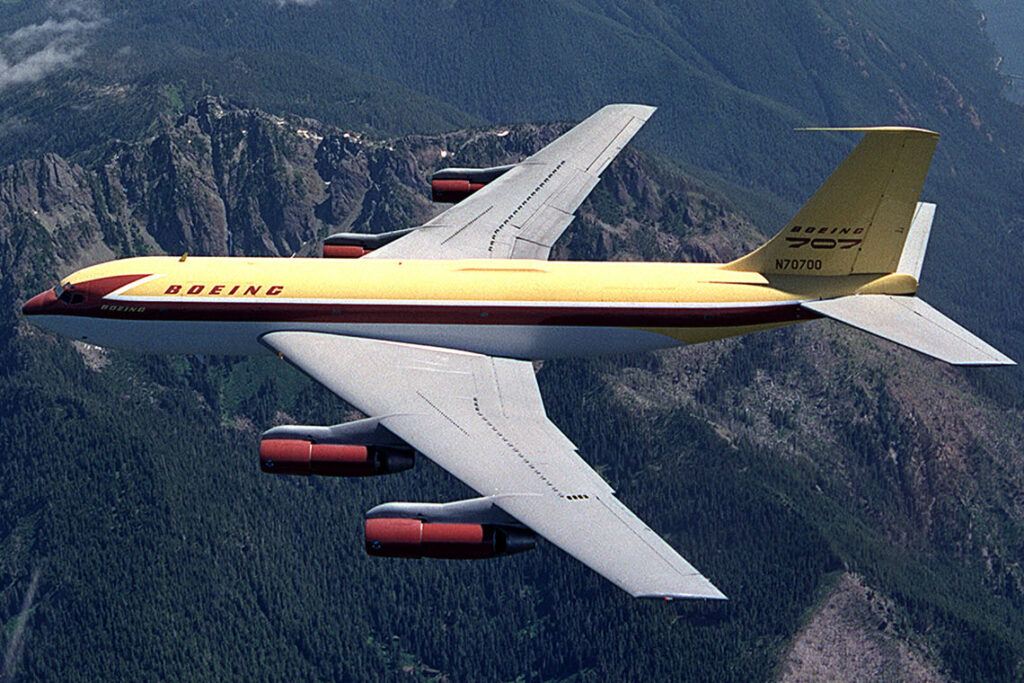
The first US-built jet airliner: the Dash 80.
The Dash 80 was, in reality, the prototype for the Boeing 707. But the name reveals an interesting story.
“Dash-80” was in reference to its development name: Boeing 367-80. The “Boeing 367” was the in-house designation for the Boeing KC-97 Stratotanker. As such, the Boeing 707 was conceived as an extension of the Stratocruiser.
How? The shape of the fuselage.
The curvature of the 707 is based on that of the C-97’s upper deck, rounding out the bottom rather than adding a lower deck.
One of the most successful airliners in aviation history, the Boeing 707 was produced from 1956 to 1978, and while none remain in civilian use in the US, some examples are still carrying passengers overseas.
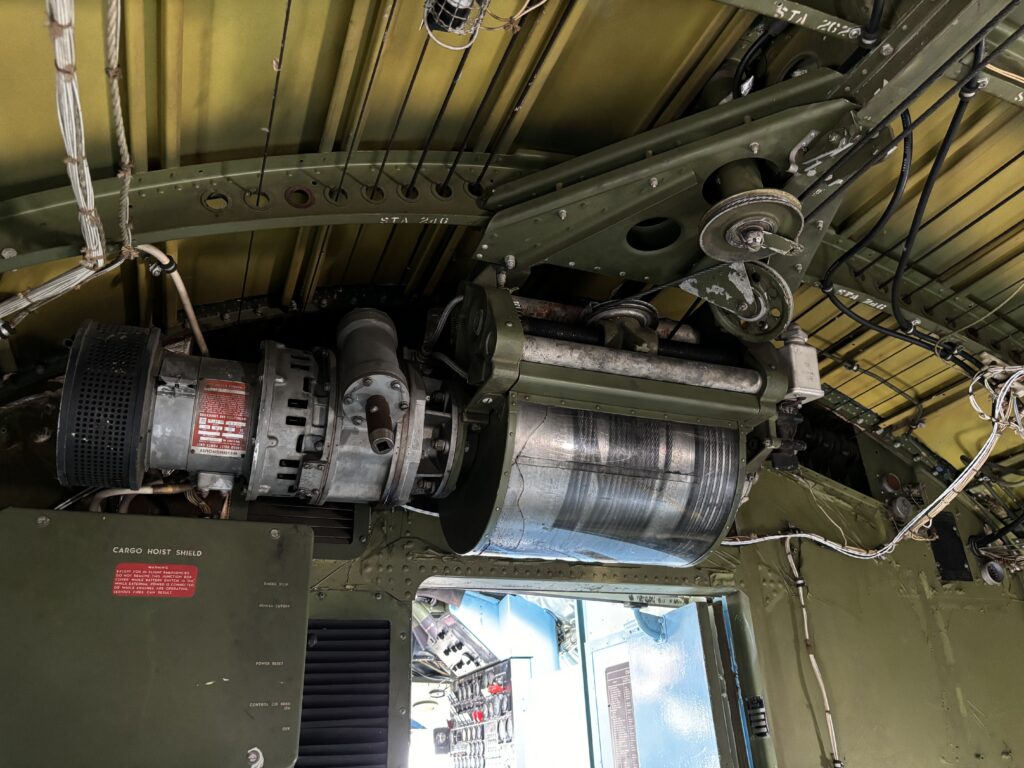
The aforementioned electric hoist at the top of the cargo hold.
The doorway underneath leads to the aircraft’s cockpit.
Photo taken 11 May 2024.
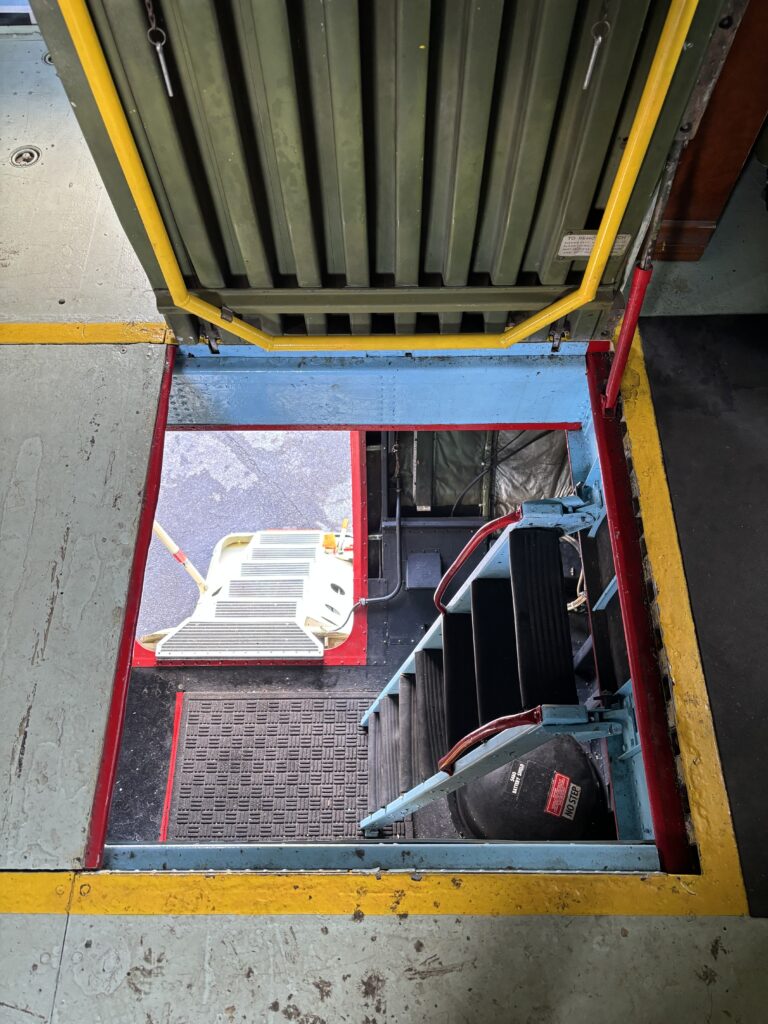
Looking down the ladder hatch into the lower compartment.
Photo taken 11 May 2024.
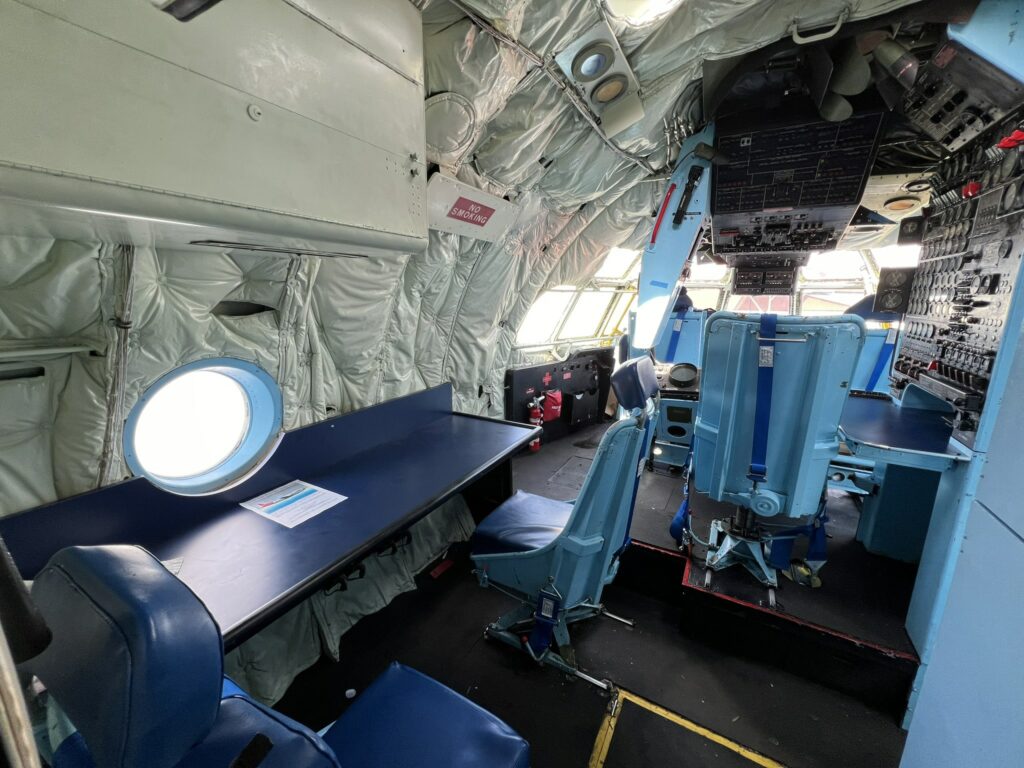
The cockpit of Angel of Deliverance.
The left two seats were for the aircraft’s navigator and radio operator. The flight engineer is in the center, with the chair swivel to the back facing the camera. The pilot positions are partially obscured by the flight engineer’s equipment. The door to the right leads to a closet, housing the aircraft’s chemical toilet.
Photo taken 11 May 2024.
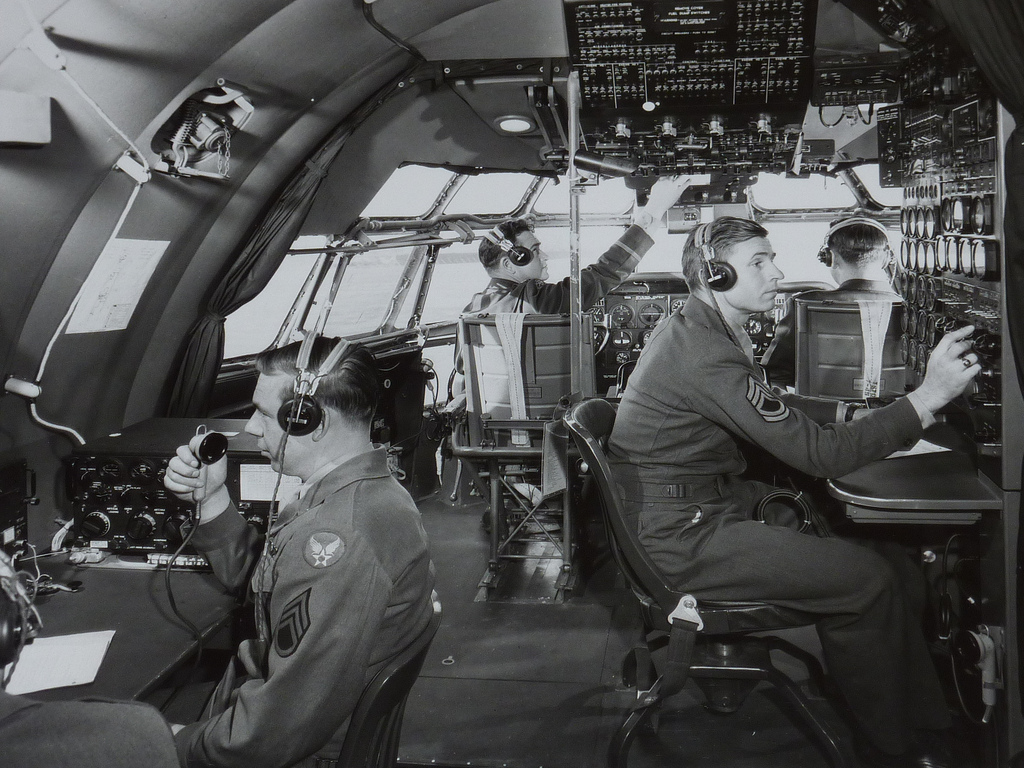
A period photo of a KC-97 Stratotanker cockpit.
Based on the design of the seats, this aircraft is older than Angel of Deliverance.
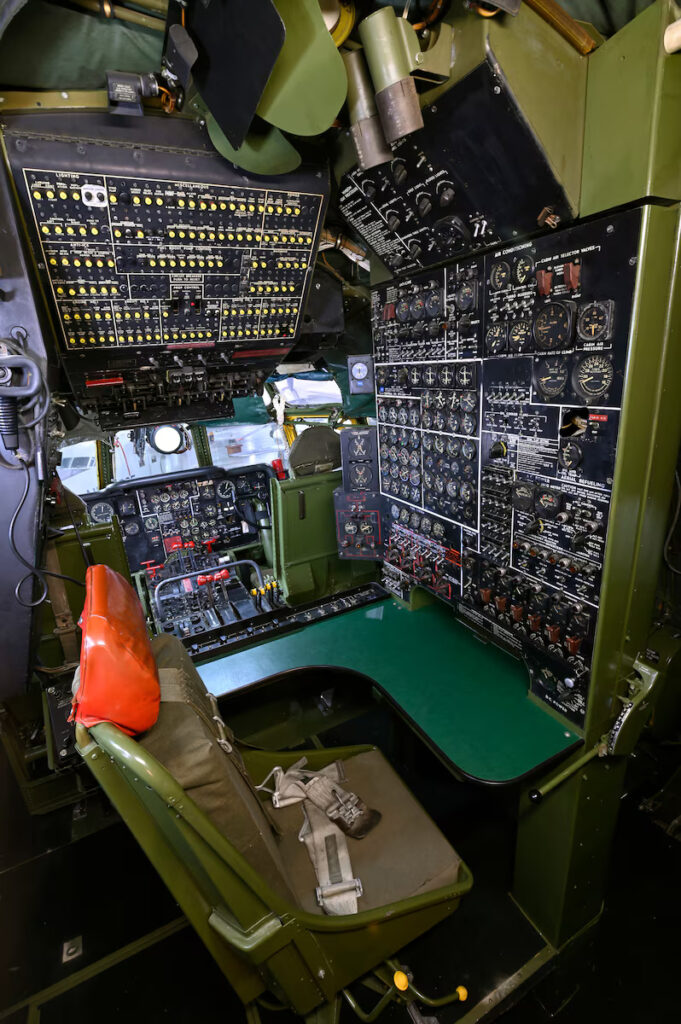
Zeppelinheim (52-2630), the KC-97 on display at the National Museum of the US Air Force. While this aircraft is a year older than Angel of Deliverance, she was put on display immediately upon retirement in 1976 and remains relatively untouched inside. Like Angel of Deliverance, Zeppelinheim was a veteran of CREEK PARTY, and was given her unique name in honor of the eponymous town near Rhein-Main.
The cockpit of Angel of Deliverance was refinished in her civilian years to reflect a more optimistic tone.

Yours truly in the pilot’s seat of Angel of Deliverance.
The last of the Boeing piston-engine greats, the view and feel of the Stratocruiser’s cockpit is magnificent.
Photo taken 11 May 2024.

Angel of Deliverance’s loading ramp, stowed in the back of the fuselage.
Photo taken 11 May 2024.
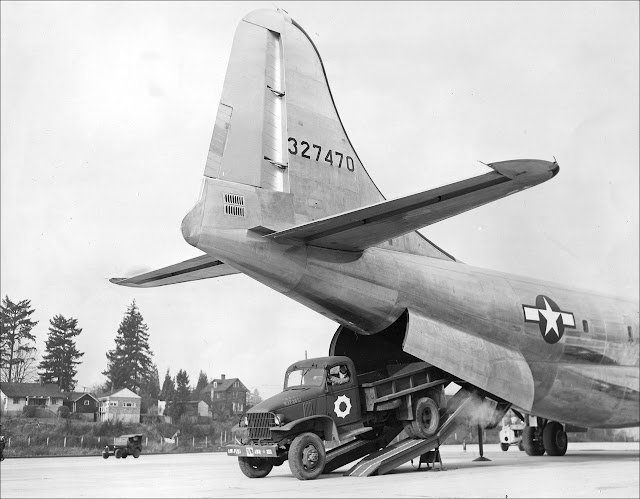
A Boeing promotional photo showing a Chevrolet G7107 truck on the ramp of a C-97.
This photo was taken sometime around January 1945.
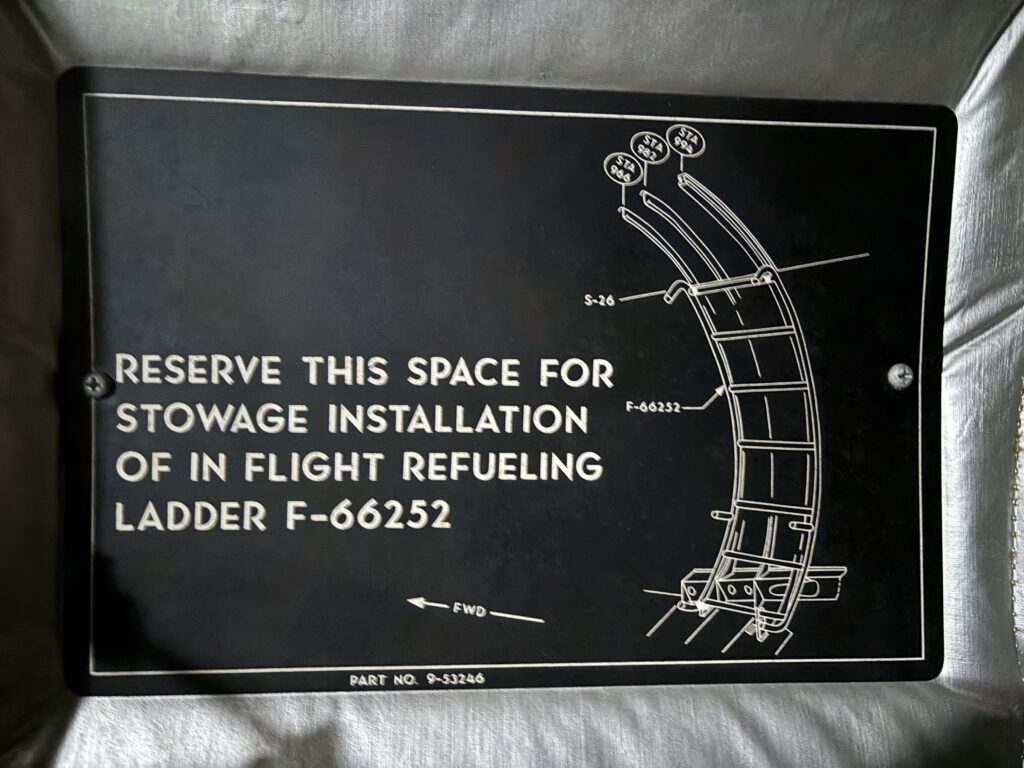
Of particular interest to us were Angel of Deliverance’s original placards.
Like the B-17, the C-97’s placards and chartage were all created using one of two fonts: American Type Founders Gothic and Bernhard Gothic. The latter (which was more stylized), can be seen here.
Photo taken 11 May 2024.
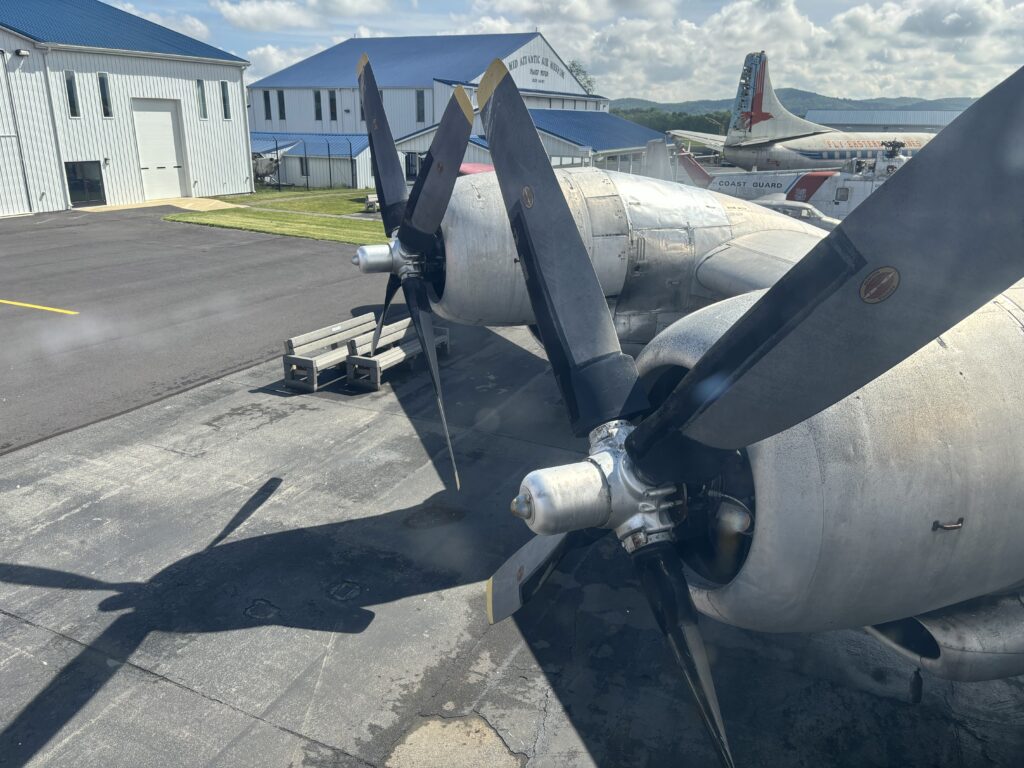
Looking out the copilot’s window at engines three and four. The distinctive underscoop on the R-4360s led to nickname “Andy Gump,” in reference to a character from the popular comic strip “The Gumps” known for distinct lack of a a chin.
Photo taken 11 May 2024.

Standing underneath Angel of Deliverance‘s engine one and two, looking toward the main entry door.
Photo taken 11 May 2024.
